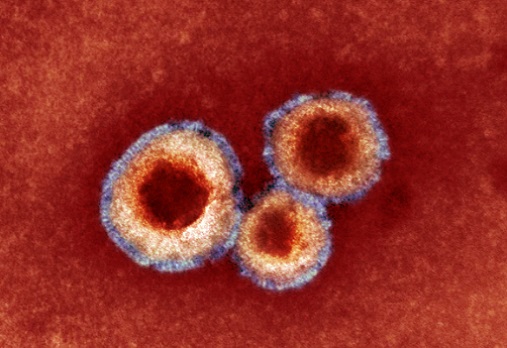Japanese Study Finds That HMPV M2-2 Protein Inhibits RIG-I Signaling by Disrupting TRIM25-Mediated RIG-I Ubiquitination
Nikhil Prasad Fact checked by:Thailand Medical News Team Jan 07, 2025 11 months, 2 weeks, 5 days, 12 hours, 10 minutes ago
Medical News: A past study has unveiled how the human metapneumovirus (HMPV) evades the body’s antiviral defenses, focusing on a small but crucial viral protein. The M2-2 protein of HMPV, a significant respiratory pathogen, has been identified as a key player in blocking the body’s first line of defense against viruses. This revelation sheds light on how HMPV undermines immune signaling, leaving the host vulnerable to infections.
 Japanese Study Finds That HMPV M2-2 Protein Inhibits RIG-I Signaling by Disrupting
Japanese Study Finds That HMPV M2-2 Protein Inhibits RIG-I Signaling by Disrupting
TRIM25-Mediated RIG-I Ubiquitination
The research was a collaborative effort by scientists from the University of Fukui, Aichi Medical University, and Shiga University of Medical Science in Japan. This
Medical News report delves into the intricate mechanisms uncovered by the study and their implications for antiviral research.
What is RIG-I Signaling and Why Does It Matter?
Our immune system employs specialized proteins like RIG-I to detect viral invaders. When RIG-I encounters viral RNA, it triggers a cascade of signals that activate interferons - potent molecules that orchestrate an antiviral response. For this system to work, RIG-I requires a helping hand from a protein called TRIM25, which modifies RIG-I through a process known as ubiquitination. This modification allows RIG-I to interact with other cellular components, ultimately leading to the activation of immune defenses.
HMPV, however, has developed a stealthy strategy to bypass this system. The study focused on how the virus uses its M2-2 protein to disrupt the critical interaction between RIG-I and TRIM25, effectively neutralizing the immune response.
Unpacking the Study's Findings
The researchers conducted experiments using human cell models to reconstitute the RIG-I signaling pathway. They introduced various HMPV proteins into the system to determine which one was responsible for sabotaging the immune response. Among all the viral proteins tested, the M2-2 protein emerged as the most effective inhibitor of RIG-I signaling.
Further analysis revealed that M2-2 prevents the ubiquitination of RIG-I by TRIM25. Ubiquitination is essential for activating RIG-I and its downstream interactions with MAVS, another protein crucial for immune signaling. Without this interaction, the entire antiviral defense mechanism is halted.
The study also demonstrated that the M2-2 protein forms a stable complex with TRIM25, targeting a specific region called the SPRY domain. By binding to TRIM25, M2-2 obstructs its ability to modify RIG-I, thus blocking the activation of interferons.
The Bigger Picture: Comparing HMPV with Other Viruses
Interestingly, the study drew parallels between HMPV and other respiratory viruses like the human respiratory syncytial virus (HRSV) and members of the Paramyxoviridae family. These viruses employ similar tactics to evade the immune system, often targeting the RIG-I/TRIM25
pathway. For instance, the NS1 protein of HRSV also inhibits RIG-I signaling by interfering with TRIM25. Such similarities highlight a common strategy used by many pathogens to outmaneuver the host's defenses.
The research team also explored how the disruption of RIG-I signaling impacts other immune pathways, such as those involving NF-kB and interferon-regulatory factors (IRFs). Their findings suggest that M2-2 not only inhibits RIG-I but also has broader implications for immune suppression, making it a versatile tool for viral evasion.
Implications for Antiviral Strategies
The study's findings open new avenues for developing antiviral therapies. By understanding how HMPV manipulates immune signaling, scientists can design drugs that counteract these effects. For instance, targeting the interaction between M2-2 and TRIM25 could restore the immune system's ability to recognize and fight the virus.
Moreover, the research underscores the potential of using attenuated viruses, such as those lacking the M2-2 protein, as vaccine candidates. However, the study noted that removing M2-2 entirely can weaken the virus too much, complicating vaccine development. Future efforts may focus on fine-tuning the virus's ability to stimulate immunity without causing disease.
Conclusion: A Step Toward Unveiling Viral Tactics
The study provides compelling evidence that the M2-2 protein of HMPV is a master manipulator of the immune system. By targeting the TRIM25-mediated ubiquitination of RIG-I, the virus effectively silences a critical antiviral pathway. These findings not only enhance our understanding of HMPV but also offer a glimpse into the broader strategies employed by respiratory viruses to evade detection.
This research serves as a stepping stone for developing targeted therapies and vaccines against HMPV and related pathogens. By deciphering the molecular tricks of viruses, we move closer to bolstering our defenses against these elusive invaders.
The study findings were published in the peer-reviewed journal: Frontiers in Immunology.
https://www.frontiersin.org/journals/immunology/articles/10.3389/fimmu.2022.970750/full
For the latest HMPV News, keep on logging to Thailand
Medical News.
Read Also:
https://www.thailandmedical.news/news/israeli-study-finds-that-human-metapneumovirus-uses-unique-strategy-to-escape-recognition-by-nk-cells
https://www.thailandmedical.news/news/louisiana-study-finds-that-human-metapneumovirus-uses-mirnas-to-impair-immune-responses-involving-interferons
https://www.thailandmedical.news/news/human-metapneumovirus-hpmv-impairs-lung-cd8-t-cells
https://www.thailandmedical.news/news/hmpv-alters-small-noncoding-rna-expression-in-airway-epithelial-cells
https://www.thailandmedical.news/articles/hmpv-human-metapneumovirus
